The Swayambhunath Stupa, an icon of Nepal, is an ancient religious structure on a hilltop in the Kathmandu Valley. It stands about 3 kilometers west of Kathmandu City and is a must-see for anyone thinking of going to Nepal. This has to be the most famous and beautiful temple in Kathmandu. The Monkey Temple or Swayambhu are other names for Swayambhunath Temple. We think this is the number one must-see place in the whole of Nepal. You can find out more about beautiful Swayambhunath here and see our original photos, old and recent.
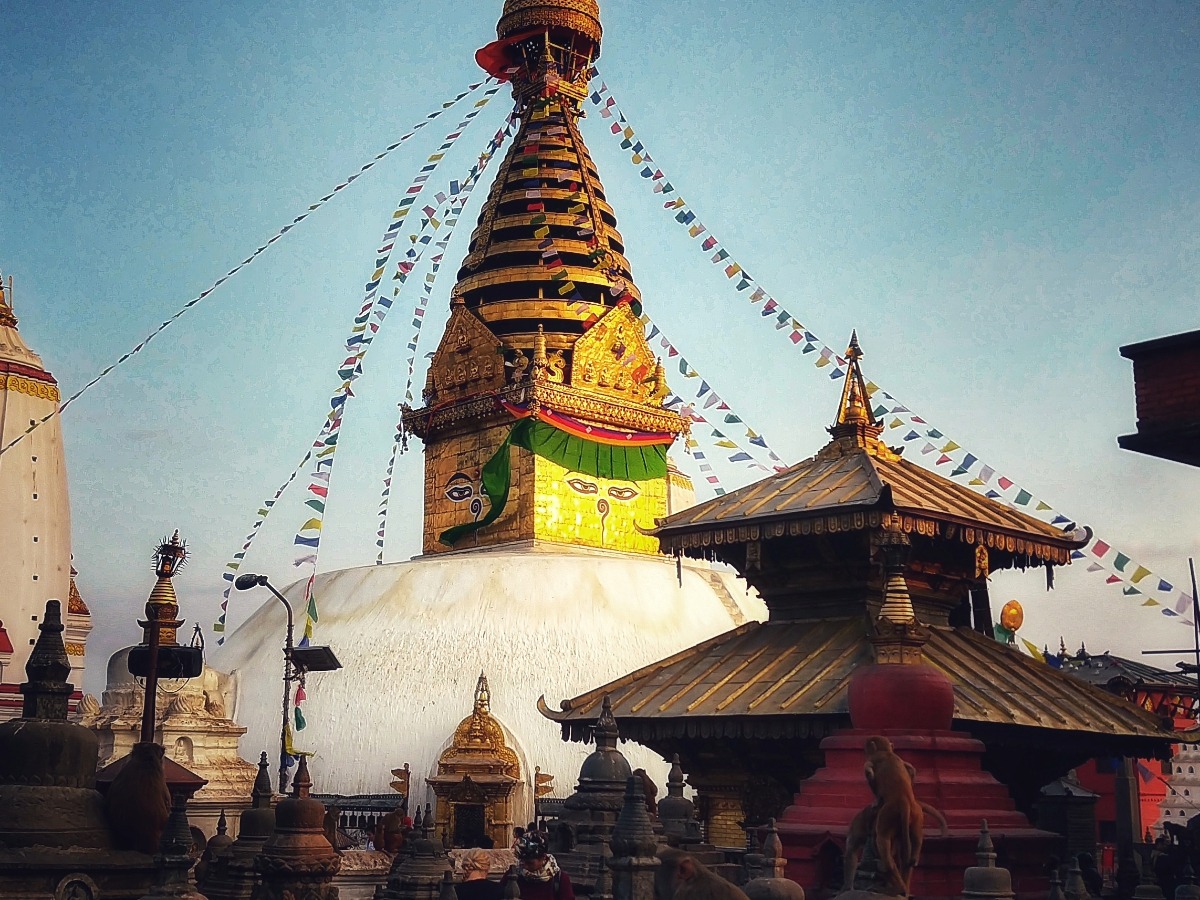
Swayambhunath
From the Swayambhunath stupa, you will have an amazing view of Kathmandu and the valley. Apart from being a very popular site for tourists to visit, it’s also a place of pilgrimage and prayer for followers of both Buddhism and Hinduism.
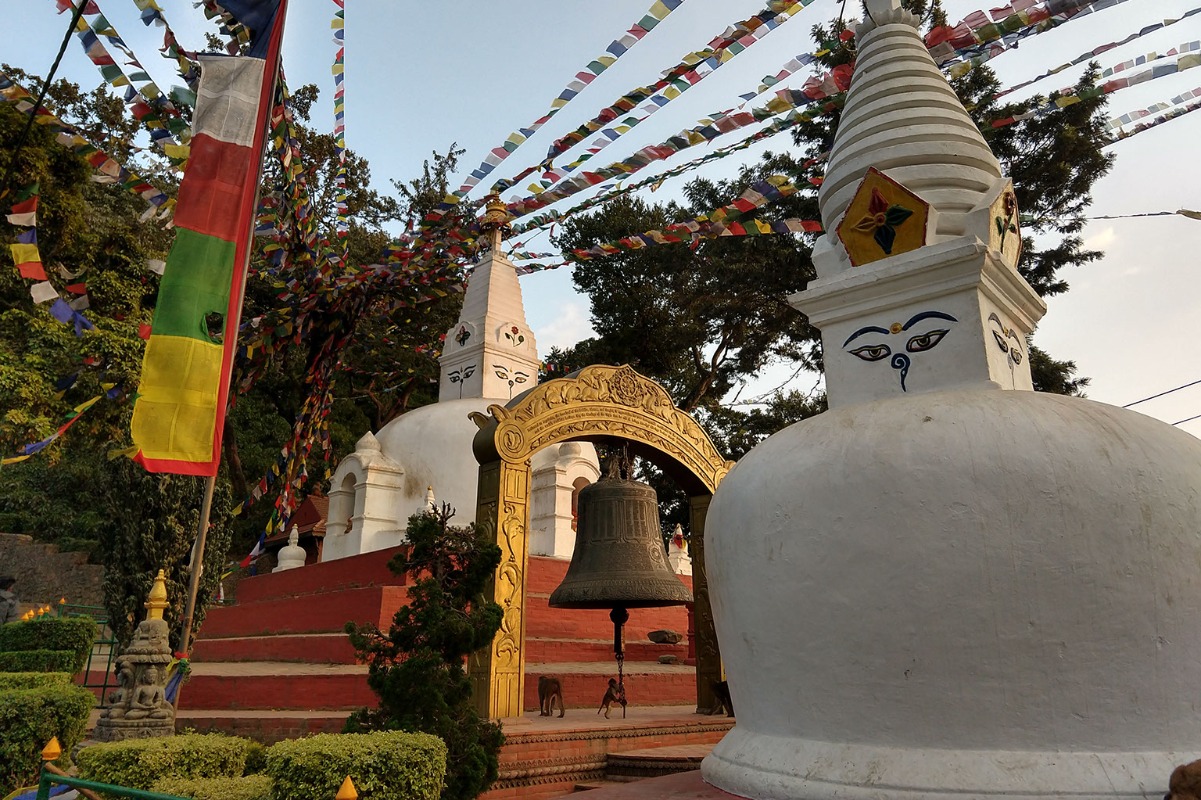
Because of this, Swayambhunath is one of the best places in the world to observe religious harmony. Swayambhunath became a UNESCO World Heritage Site in 1979.
Save the photos below to Pinterest!
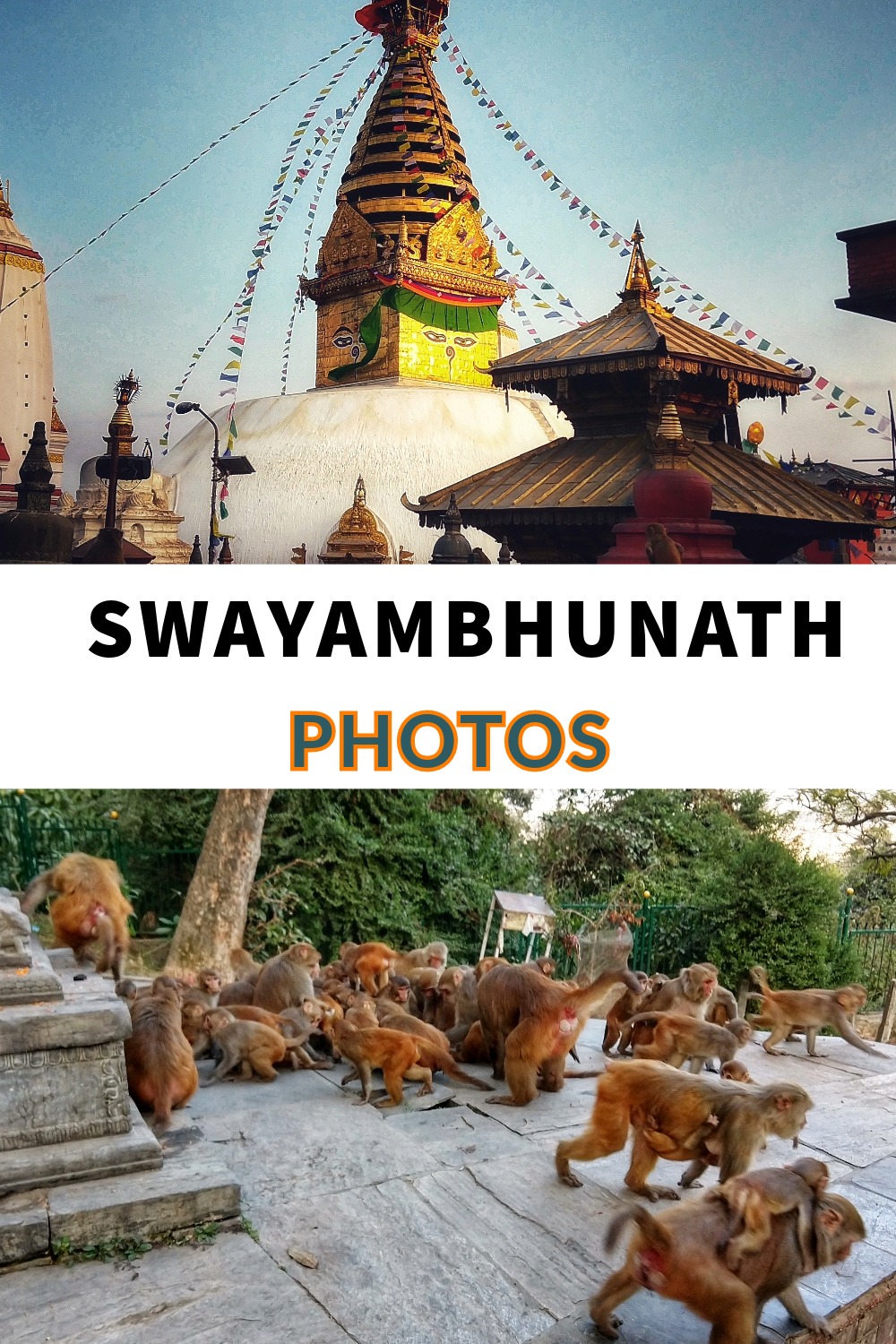
The Swayambhunath monkeys can be a menace. These were crowding around a local person feeding them. Keep your distance, they can bite.
Swayambhunath Video
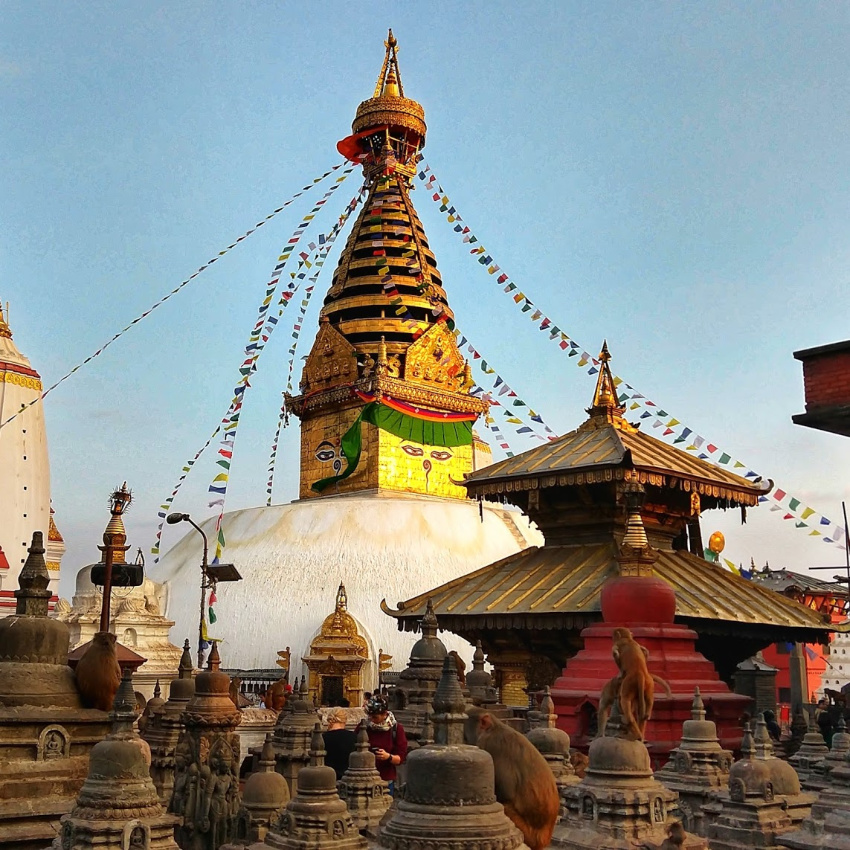
We made a very short video to show you more of Swayambhunath so take a quick look.
History and Religious Significance of Swayambhunath
You won’t find a stupa in Nepal older than this one. Historical records found engraved in stone show that it was already an important shrine for pilgrims in the 5th century A.D. It’s now one of the most sacred pilgrimage sites for Buddhists and a must-see for tourists.
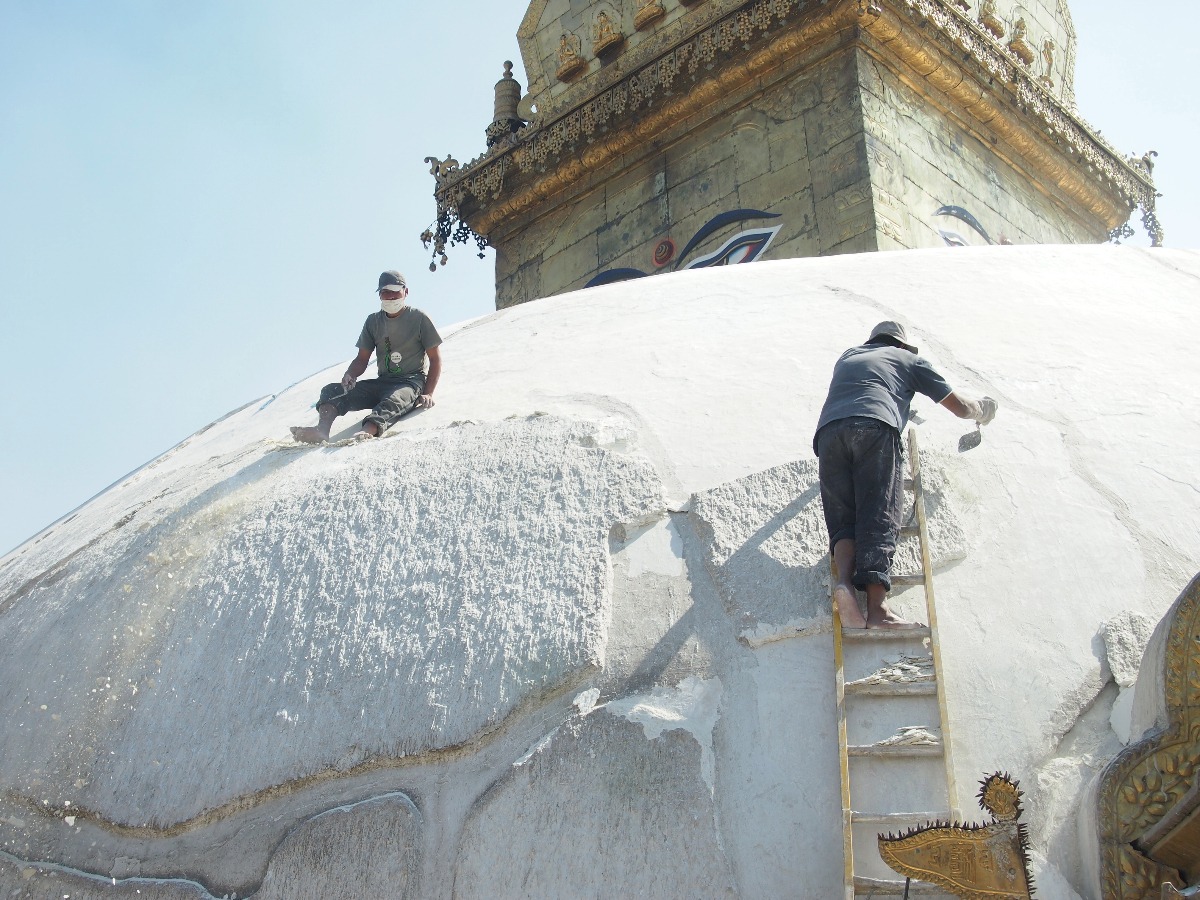
According to Buddhist scripture, in the form of Swayambhunath Purana (a collection of stories about the origin and development of Kathmandu Valley), the valley was once a huge lake. From this lake a lotus grew, and it radiated a dazzling light.
People came from all over the land to see this light, which they believed bestowed them with enlightenment.
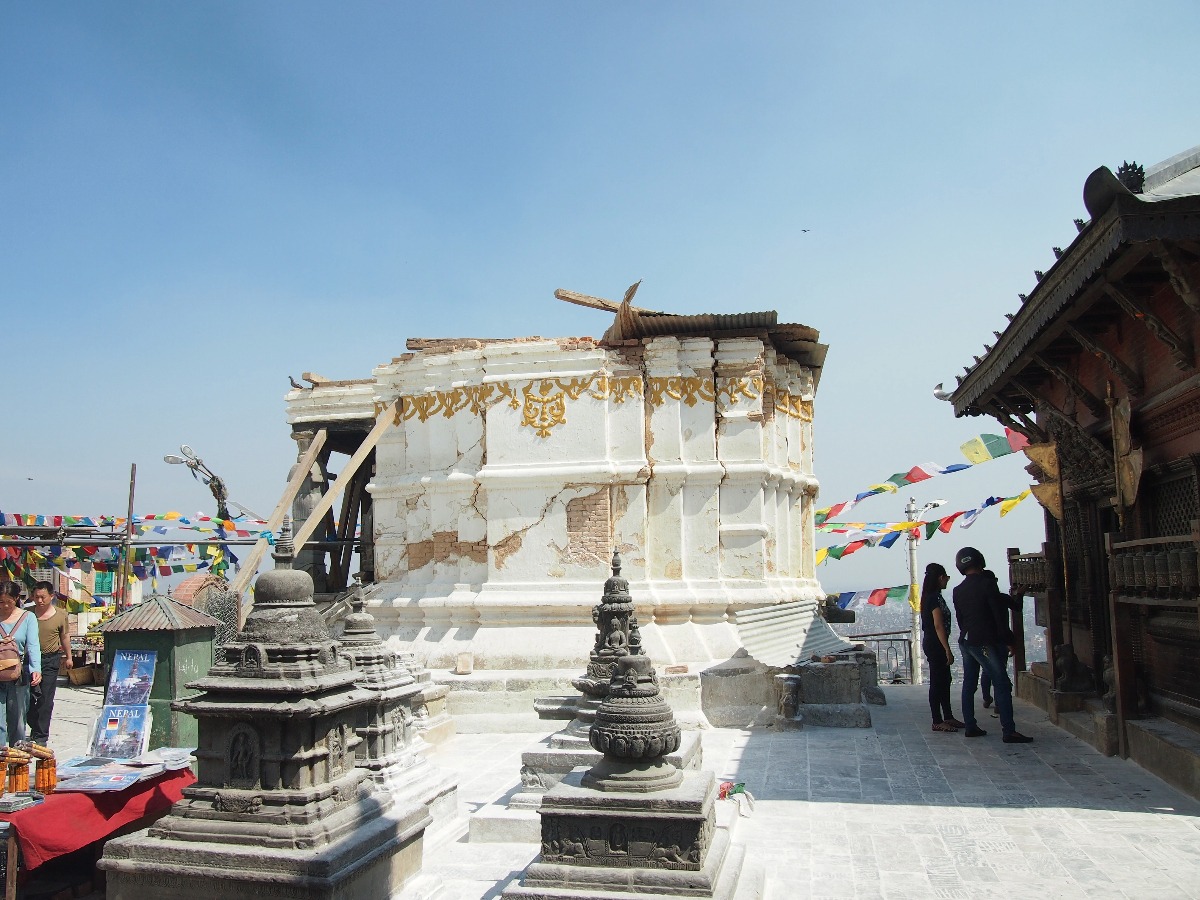
Manjushri, the bodhisattva of wisdom and learning, was meditating at this time and felt compelled to go and worship the shining lotus. Manjushri decided that without the waters of the lake, more human pilgrims would also be able to come and experience the light from the lotus. So with his sword he cut a gorge in the surrounding mountains and the lake drained away, leaving the valley of Kathmandu. Then the lotus became a hill, and the light turned into the stupa.
The valley is now known as Swayambhu or Swayambhunath, which means ‘self-created’ or ‘self-existent’.
Swayambhunath is also called The Monkey Temple
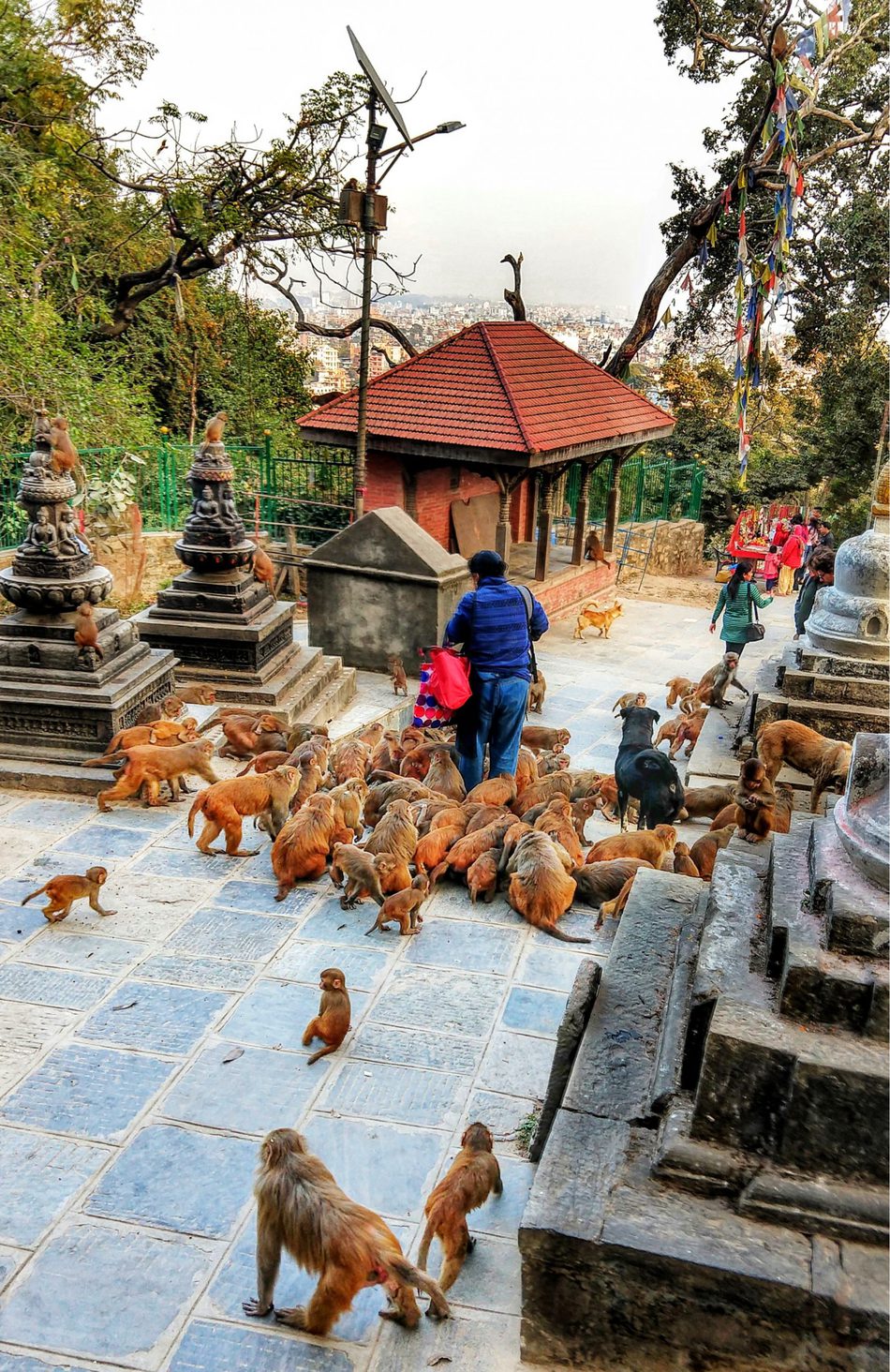
Swayambhunath stupa is ‘The Monkey Temple’ because there are hundreds of monkeys who live there. These days the whole Swayambhunath complex is over-run with monkeys and bites are not uncommon. Although they’re rather energetic during the day, it’s at night after the pilgrims, priests, and tourists have gone home, that the monkeys are at their most active.
The monkeys are considered holy because according to mythology, Manjushri was in the process of raising the hill which would later become the location of the stupa. Although he was expected to keep his hair short, he grew it long and this attracted head lice.
Legend tells us that these lice turned into the monkeys which are now resident on the hill.
How to get to Swayambhunath Stupa Nepal
It’s best to get to Swayambhunath is to just hop in a taxi from central Kathmandu or Thamel. Hailing a taxi on the street is pretty straightforward. You can walk, we’ve walked. It’s a fair way but an interesting walk.
Expect to pay around $3-4 for a taxi and always negotiate on price. Some taxi drivers will wait for you and take you back to the city. This will normally be a cheaper price than 2 singles and the taxi drivers at Swayambhunath itself are cut-throat.
They know you need to get back, so walk a little way away for a better price.
There are two ways to access the top of the hill. To the east side, there are steep steps that lead up to the stupa. If you’re not in good shape or have health problems it might be best to use the road entrance on the western side in your car or taxi.
Consider booking a tour, below, so as to make your time in Kathmandu as easy as possible
Tours To Swayambhunath to Book
For complete peace of mind and an easy day, book a tour or private driver. A half-day or full-day tour can get you around all of Kathmandu’s major destinations quickly and efficiently, without the drama. Take a look at tour options here. Walking tours are also available at this link.
The Eastern Staircase at Swayambhunath
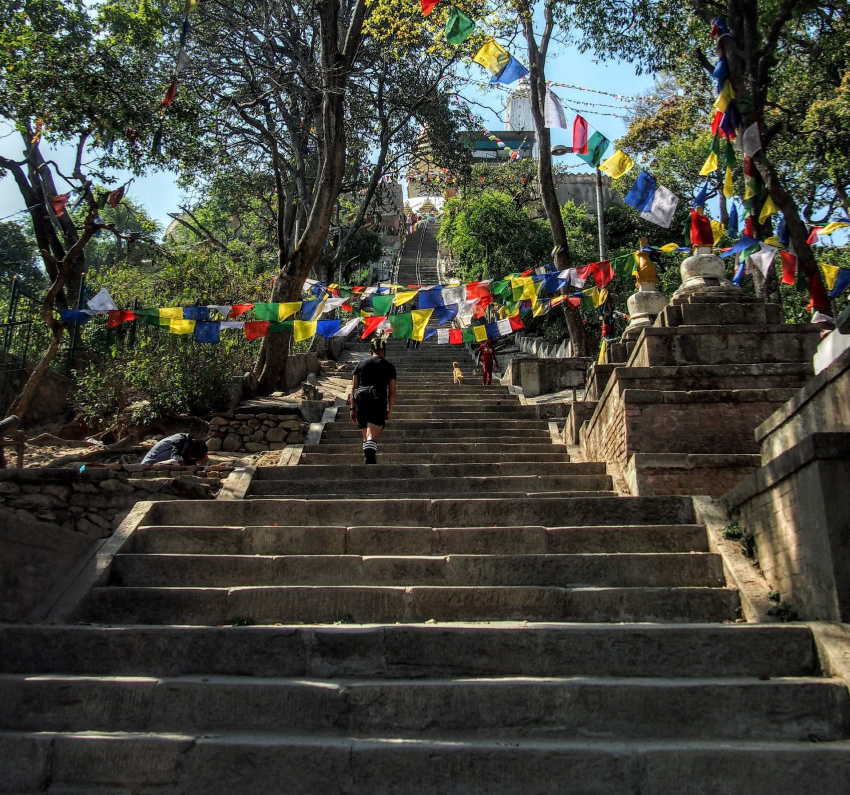
Every morning before dawn, hundreds of pilgrims (Vajrayana Buddhists and Hindus) take the steps up to the stupa and begin their circumambulations of the stupa in a clockwise direction. The Newari Buddhists go in the opposite, anti-clockwise, direction.
If you decide to take the steps, which are believed to have been constructed in the 17th century, there are over 300 of them and they’re quite steep. Be prepared for the challenge.
The Western Entrance
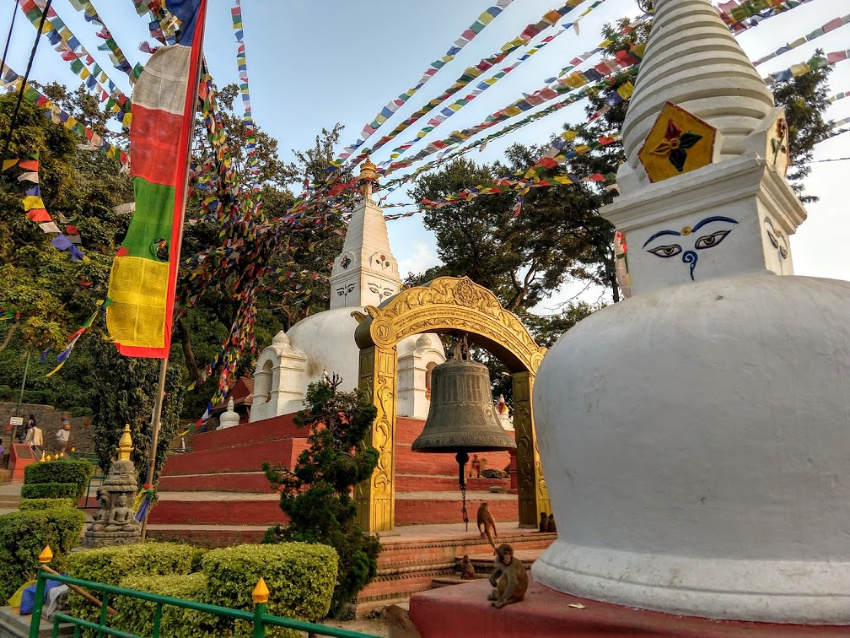
You will arrive near the top, leaving you with a shorter walk the rest of the way. Taking this entrance, you find 3 huge golden Buddha statues and a garden with sacred ponds. The Peace Pond and memorial is here. Watch out for stray dogs and monkeys because they can be aggressive. Your taxi will most likely be more expensive if you ask for a drop off at this entrance.
Admission Price For Swayambhunath
Entrance for foreigners to the stupa is about NPR 200, and it’s open 24 hours. There are ticket booths at both entrances to Swayambhunath, western and eastern.
The Swayambhunath Stupa
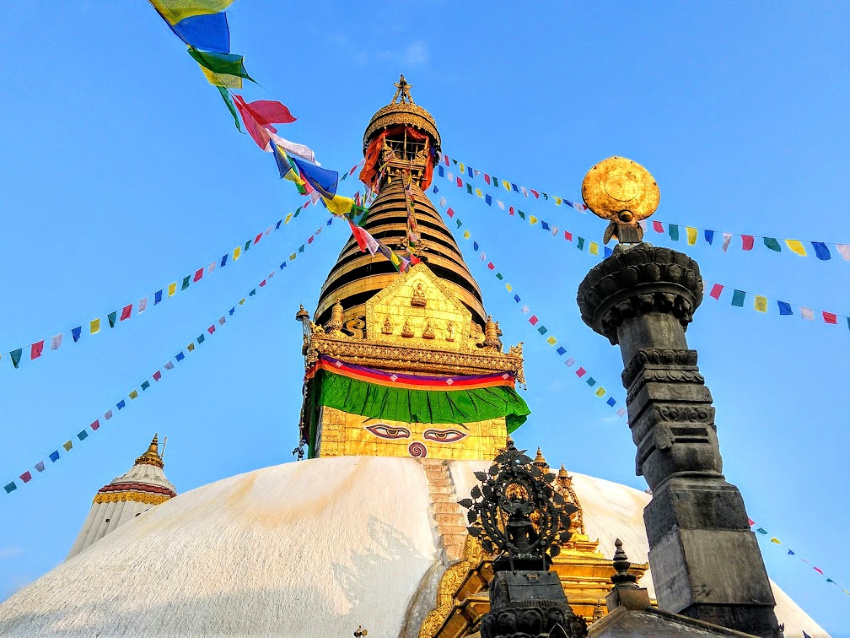
The stupa itself is made up of a base, which is a dome shape and represents the globe of the earth.
Upon the dome sits a cubed structure, painted with eyes on each side. These are the eyes of Buddha or eyes of peace, and they’re looking in all directions. There’s no nose under the eyes, but a number ‘1’ in the Nepali alphabet, which represents unity of all things.
There is also a third eye above each pair of eyes. These third eyes symbolise the all-seeing insight of Buddha.
Pentagonal toran with statues carved in them sit on top of the cubed structure. These carvings are of Panch (5) Buddhas, which are Buddha in a metaphorical sense in Tantrayana (these are Vairochana, Akshobhya, Ratna Sambhava, Amitabha and Amoghsiddhi).
Rising up from behind the toran are 13 tiers, recently re-gilded with 20 kilograms of gold. The 13 tiers represent the 13 stages that humans must pass through before reaching Nirvana.
And finally above the 13 tiers there is the gajur (pinnacle).
View of Kathmandu City From Swayambhunath
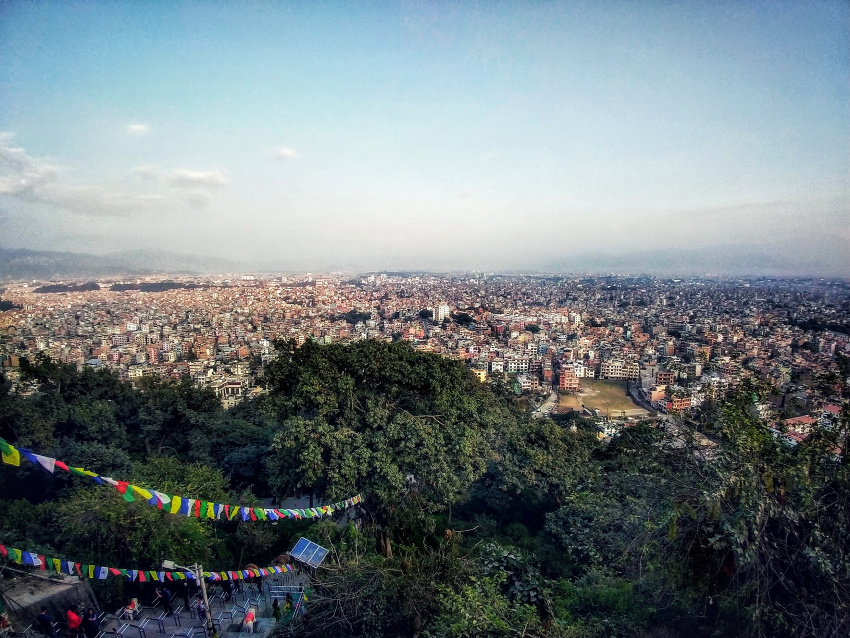
To get the best view of the city try to come early or late to see the light at its best. I’ve seen some spectacular shots taken up here in the dark or for sunrise.
To get to this viewing platform you will need to pay the temple admission because there’s not much of a view from the steps. The platform is to the left of the giant thunderbolt as you arrive.
Kathmandu has terrible air pollution so expect haze. The clearest skies are often during the autumn trekking season. You can see the steps in the bottom left in the photo above.
What Else to See at Swayambhunath?
In addition to the stupa, there are several other shrines, temples, and other religious objects to see here. The temples are beautifully decorated with prayer flags and gold.
The Enormous Brass-Plated Vajra
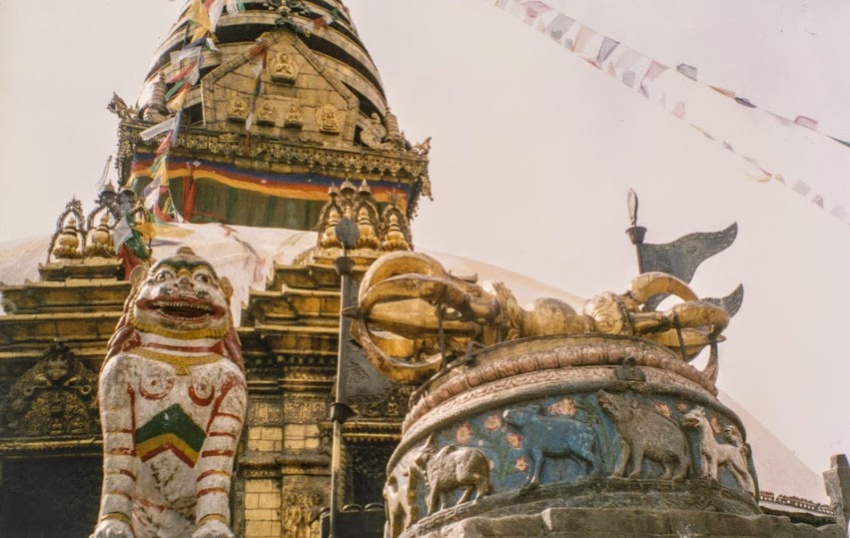
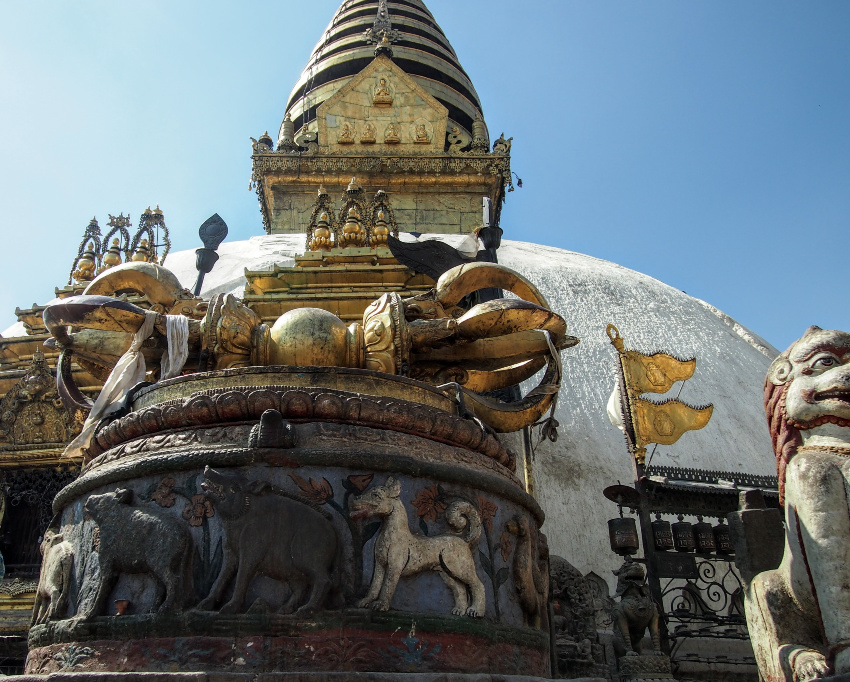
The enormous brass-plated Vajra (thunderbolt or dorje) is set in the east side of the stupa near the entrance. It’s at the top of those very steep steps. It’s a symbol of Tibetan Buddhism and represents the power of enlightenment. It’s decorated with the animals of the Tibetan calendar. Lions sit on either side of the Vajra.
Buddha Statue
Another attraction at Swayambhu stupa is the huge Buddha statue which you can see on the west side of the stupa.
The World Peace Pond at Swayambhunath

The World Peace Pond holds a monument to world peace. The monument is a small globe inscribed with ‘World Peace’ both in English and Nepali. It sits in front of a brass statue of Buddha standing on a lotus. There are also words on the wall behind the statue, which say ‘May Peace Prevail On Earth’ again, in English and Nepali.
The small pot, or cauldron, at Buddha’s feet is for tossing coins into to make a wish. There are no coins used in Nepal now, but you can buy coins right next to the pond if you want to try your luck and make a wish.
The Dewa Dharma Monastery
Visit the Dewa Dharma Monastery while you’re here. You’ll see a bronze icon of Buddha, along with traditional Tibetan paintings.
The Harati Temple
Harati is the protector of all children, as well as being the goddess of smallpox and other epidemics, and at Swayambhunath there’s a temple dedicated to her. According to legend, before she became a goddess she was an ogress who collected children to feed her large family. The local people were very afraid of her, so they asked Buddha for some protection. So Buddha convinced Harati to stop eating their children and causing so much suffering to the people. Thus she became the caretaker and protector of all children.
It’s interesting to note here that Harati is actually a Hindu deity, and as the Buddhists had no deity of their own to protect them against smallpox, they adopted Harati for this purpose.
This temple is a small brick pagoda and is naturally very popular with women who come with food offerings such as bread and rice, seeking blessings for their children.
Shantipur
Shantipur is another temple that is worth a look while visiting Swayambhunath. It’s known as ‘the place of peace’, and inside there is a secret chamber which is always locked. In this chamber lives the 8th-century Tantric master, Shantikar Acharya. Apparently he’s stayed alive by practising meditation techniques.
He also has complete control over the weather and when there is the threat of drought in the valley, the King of Nepal has to enter the underground chamber. There he retrieves a secret mandala from Shantikar and takes it outside and presents it to the sky. Very soon after that, rain starts to fall and the threat of drought is averted.
This event last occurred in 1658, and is depicted in the frescoes which are painted inside on the temple walls.
Prayer Wheels
The base of the Swayambhunath stupa is surrounded by prayer wheels. Religious visitors to the site spin each wheel with their hands as they walk around the stupa. It’s a form of reciting prayer, silently. Each spin releases a prayer into the universe.
The prayer wheels here are embossed with the sacred mantra ‘om mani padme hum’ (‘hail to the jewel in the lotus’). Both Buddhist and Hindu pilgrims, as well as other visitors to the site, spin the wheels to accumulate good karma and wisdom, also to eliminate bad karma. There are around 6,000 prayer wheels around Swayambhunath hill.
Prayer Flags
As well as the prayer wheels, the prayer flags also carry similar mantras, and thousands of them flutter above the stupa. The flags are very colourful rectangular pieces of material, and people place them outside to promote compassion, peace, strength, and wisdom, and to bless their surroundings. The colours are said to represent the 5 elements – earth, water, air, fire and sky.
The ‘Wind Horse’ carries the mantras and prayers from the flags up to heaven.
Shree Karma Raja Mahavihar Monastery
Note: The monastery became structurally unsound after the earthquake in 2015, and was taken down. Reconstruction was expected to be completed in August 2020.
This ancient monastery is in the northeast corner of the site, and is an active monastery. There is a big Buddha statue and candles made from yak butter which are lit by pilgrims. You can hear the resident monks chant every day at around 3 or 4 pm.
The Shree Karma Raja Mahavihar is a main seat of His Holiness the 17th Gyalwa Karmapa in Nepal.
Agnipur
In the northwest corner of the site is a neglected shrine to the ancient Hindu fire god, Agni. It’s marked by 2 small lions in front of it. Agni is the relayer of burnt offerings to heaven.
Nagpur
Nagpur is at the north of the main stupa, and is a small tank, the size of a bath-tub, with a snake ‘idol’ at the bottom of it. You can see the snake when there’s no water in the tank. Nagpur’s purpose is to appease the valley’s snake spirits.
Graves & Cemetary at Swayambhunath
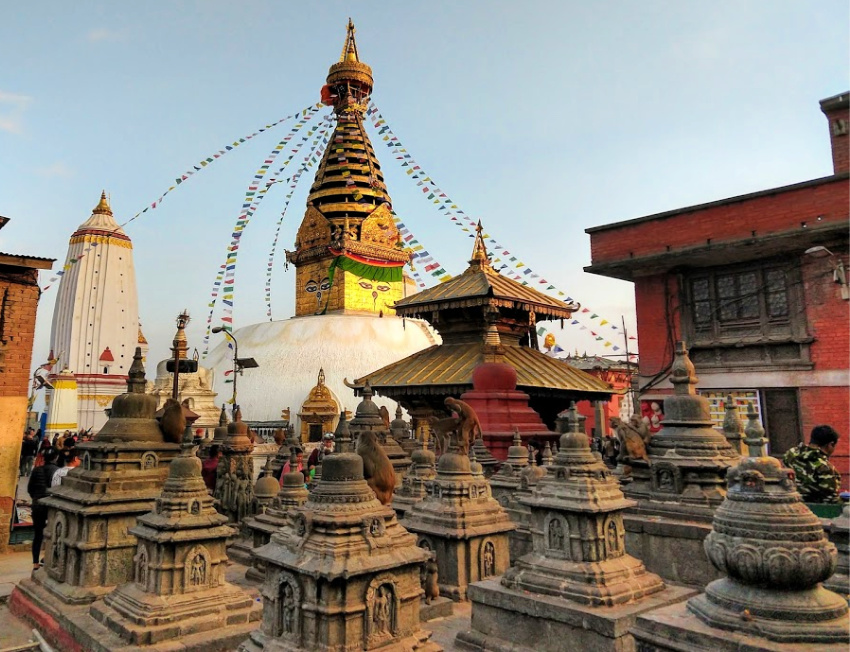
In the courtyard of Swayambhunath there are many monuments to the monks who lived in the monasteries and died there. The monkeys, as you can see above, are rather fond of this area.
Earthquake Damage at Swayambhunath
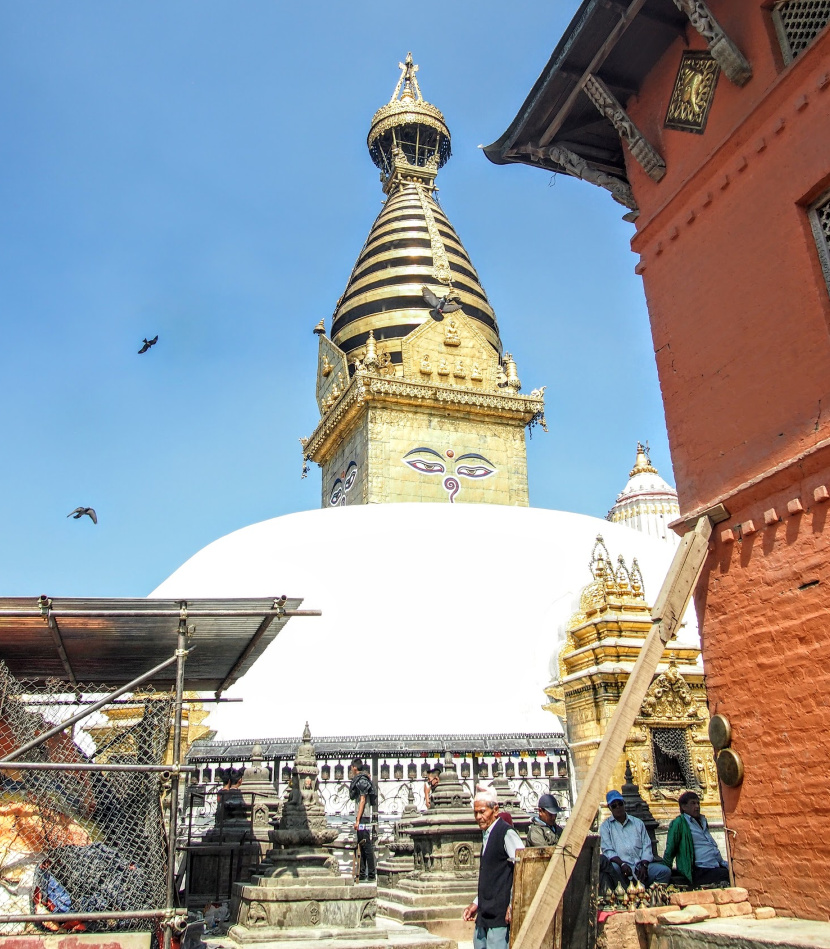
We visited Swayambhunath before the earthquake, 11 months after the earthquake and again 18 months later. The last time we visited the repairs were almost complete. Sadly there was a distressing amount of damage at this site but it’s looking good again now. If anything, there are more monkeys than ever.
Refreshments and Souvenirs at Swayambhunath Temple
Like at most tourist sites, at Swayambhu you’ll find various cafes and kiosks, and other shops where you can get refreshments and souvenirs.
Many are located on the walk up from the peace pond on the shorter staircase. Likewise, there are some interesting trinket shops on this hill selling singing bowls, kukris, and all the usual Kathmandu souvenirs.
There may also be stalls on the steps as you walk up.
Important days to visit Swayambhunath
1. Buddha Purnima – the birthday of Lord Buddha, which falls on the full moon day of Baishak (April-May)
2. Gunla the holy Buddhist month according to Newari calendar (Aug-Sept – early Morning).
3. Kojagrath Purni (Sept-Oct)
4. Samyak day of the Magh (Jan-Feb – every twelve years)
Where to Stay Near Swayambhunath
It doesn’t really matter where you stay in Kathmandu because most places are easily accessible and getting around is cheap.
Most backpackers stay in or near Thamel. It’s a wonderful area, full of trekking stores, food opportunities and ancient buildings but these days it’s becoming more and more polished.
Up-market coffee-shops, boutique hotels and fancy restaurants are appearing. From Thamel you can easily walk into stunning areas of old Kathmandu such as Durbar Square, Freak St. and, indeed, Swayambhnath Stupa.
Our top picks for accommodation are below. Please check these recommendations suit your needs, what’s good for us may not be what’s good for you.
| Best Accommodation in Kathmandu | Features | Book Hotel Here / Check Prices/ Availability |
|---|---|---|
| Best Luxury Hotel | The Kathmandu Marriott wins for us because of its better location. The Hyatt Regeny Kathmandu is also good but it’s out at Boudhha, handy for Boudhhanath Temple and closer to the airport. The Marriott is closer for Swayambhunath and the city. Both are great international hotels with good review scores. | Check Price |
| Best 5 Star With Character | The Hotel Yak & Yeti is where you want to be for local character! This hotel is in a heritage palace. There are pools, a casino, dining and beautiful gardens. This one in central, near the Marriott above. It’s usually cheaper than The Marriott | Check Price |
| Best for Families, Budget | Family rooms for 4 can be hard to come by in Kathmandu, 3 seems more common. Monkey Temple Homestay has rooms for 4 and is very near Swayambhunath | Check Price |
| Best for Families, Mid Range | Maya Boutique Hotel has family rooms for 4, possibly 5. ( check). It’s in Thamel, so easy access, everywhere. Superb reviews. | Check Price |
| Best for Families, Luxury | I’m not seeing family rooms at any of the big 5 star hotels, two doubles could work. See the links above for Hyatt, Marriott, Yak and Yeti. | |
| Best Backpacker Hostel for Singles or Families | Rest Up Kathmandu Hostel has mixed dorms and family rooms, superb reviews. A good location in Thamel | CHECK PRICE |
More Nepal Videos and Information
We have a lot more Nepal content with videos from favourite and popular destinations in Nepal. Just head to our Nepal archive page to find what you need.
Swayambhunath is one of my favourite places in the incredibly ancient city of Kathmandu. This city is a wonderland of ancient structures and monuments and there’s enough here to keep you fascinated for weeks. Sadly most trekkers only have a day or two to enjoy Kathmandu before taking off to the mountains so if you can, stay longer. Kathmandu is dear to my heart and we’ve now spent months there so we hope you enjoy Kathmandu. We have a full guide to Things to Do in Kathmandu here, along with a guide to Trekking in Nepal. See the related posts below for more of our Nepal coverage.
If you'd like to hire a car during your stay, use this car rental comparison tool to find the best deal!
We also suggest you take a look at this company to get a quote for all kinds of the more tricky adventure or extended travel insurance.
Try Stayz / VRBO for an alternative way to find rentals on homes/apartments/condos in any country!

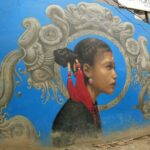
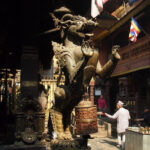
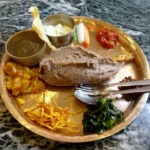
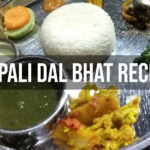
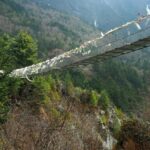
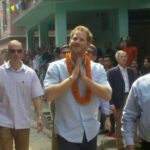
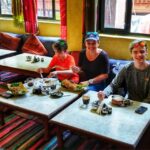
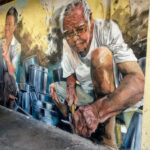
Swayambhunath “The Monkey Temple ” is one of the most tourist attraction places to visit in Nepal. This temple is at the Heart of the Kathmandu where the number of Stupas can be found out there. It is also regarded to be at the Peace Place to find out in Kathmandu Valley.
Love the way you have explored there around, the information and background of the places you have described are so readable.